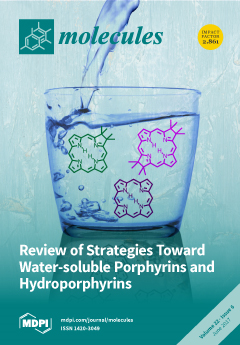1
School of Pharmacy, College of Pharmacy, Kaohsiung Medical University, Kaohsiung 807, Taiwan
2
Department of Fragrance and Cosmetic Science, College of Pharmacy, Kaohsiung Medical University, Kaohsiung 807, Taiwan
3
Research Center for Natural Products and Drug Development, Kaohsiung Medical University, Kaohsiung 807, Taiwan
4
Center for Infectious Disease and Cancer Research, Kaohsiung Medical University, Kaohsiung 807, Taiwan
5
Department of Medical Research, Kaohsiung Medical University-Hospital, Kaohsiung 807, Taiwan
6
Ph.D. Program in Toxicology, Kaohsiung Medical University, Kaohsiung City 807, Taiwan
7
Department of Medicinal and Applied Chemistry, College of Life Science, Kaohsiung Medical University, Kaohsiung 807, Taiwan
8
Division of Infectious Diseases, Department of Internal Medicine, Kaohsiung Medical University-Hospital, Kaohsiung Medical University, Kaohsiung 807, Taiwan
9
School of Medicine, College of Medicine, Kaohsiung Medical University, Kaohsiung 807, Taiwan
10
Department of Laboratory Medicine, Kaohsiung Medical University-Hospital, Kaohsiung Medical University, Kaohsiung 807, Taiwan
11
Center for Dengue Fever Control and Research, Kaohsiung Medical University, Kaohsiung 807, Taiwan
12
Graduate Institute of Natural Products, College of Medicine, and Chinese Herbal Medicine Research Team, Healthy Aging Research Center, Chang Gung University, Taoyuan 333, Taiwan
13
Research Center for Chinese Herbal Medicine, Research Center for Food and Cosmetic Safety, and Graduate Institute of Health Industry Technology, College of Human Ecology, Chang Gung University of Science and Technology, Taoyuan 333, Taiwan
14
Department of Anesthesiology, Chang Gung Memorial Hospital, Taoyuan 333, Taiwan
add
Show full affiliation list
remove
Hide full affiliation list
Abstract
A series of indeno[1,2-
c]quinoline derivatives were designed, synthesized and evaluated for their anti-tuberculosis (anti-TB) and anti-inflammatory activities. The minimum inhibitory concentration (MIC) of the newly synthesized compound was tested against
Mycobacterium tuberculosis H
37R
V. Among the tested compounds,
[...] Read more.
A series of indeno[1,2-
c]quinoline derivatives were designed, synthesized and evaluated for their anti-tuberculosis (anti-TB) and anti-inflammatory activities. The minimum inhibitory concentration (MIC) of the newly synthesized compound was tested against
Mycobacterium tuberculosis H
37R
V. Among the tested compounds, (
E)-
N′-[6-(4-hydroxypiperidin-1-yl)-11
H-indeno[1,2-
c]quinolin-11-ylidene]isonicotino-hydrazide (
12), exhibited significant activities against the growth of
M. tuberculosis (MIC values of 0.96 μg/mL) with a potency approximately equal to that of isoniazid (INH), an anti-TB drug. Important structure features were analyzed by quantitative structure–activity relationship (QSAR) analysis to give better insights into the structure determinants for predicting the anti-TB activity. The anti-inflammatory activity was induced by superoxide anion generation and neutrophil elastase (NE) release using the formyl-
l-methionyl-
l-leucyl-
l-phenylalanine (fMLF)-activated human neutrophils method. Results indicated that compound
12 demonstrated a potent dual inhibitory effect on NE release and superoxide anion generation with IC
50 values of 1.76 and 1.72 μM, respectively. Our results indicated that compound
12 is a potential lead compound for the discovery of dual anti-TB and anti-inflammatory drug candidates. In addition, 6-[3-(hydroxymethyl)piperidin-1-yl]-9-methoxy-11
H-indeno[1,2-
c]quinolin-11-one (
4g) showed a potent dual inhibitory effect on NE release and superoxide anion generation with IC
50 values of 0.46 and 0.68 μM, respectively, and is a potential lead compound for the discovery of anti-inflammatory drug candidates.
Full article






